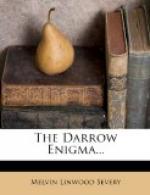“Truth! Bah!” he exclaimed excitedly. “I have no patience with such aesthetic hod-carriers! Truth, indeed! Is there no other truth in art but that coarse verisimilitude, that vulgar trickery, which appeals to the eyes and the ears of the rabble? Are there not psychological truths of immensely greater importance? What sane man imagines for a moment that the pleasure he derives from seeing that greatest of all tragedians, Edwin Booth, in one of Shakespeare’s matchless tragedies, is dependent upon his believing that this or that character is actually killed? Why, even the day of the cranberry-juice dagger is long since passed. When Miss Davenport shrieks in ‘Fedora,’ the shriek is literal—’real,’ you would call it—and you find yourself instinctively saying, ‘Don’t!—–don’t!’ and wishing you were out of the house. When Mr. Booth, as ‘Shylock’ shrieks at ‘Tubal’s’ news, the cry is not real, is not literal, but is suggestive, and you see at once the fiendish glee of which it is the expression. The difference between the two is the difference between vocal cords and grey matter.”
“But surely,” I rejoined, “one doesn’t want untruth; one wants—” but he did not let me finish.
“Always that cry of truth!” he retorted. “Do you not see how absurd it is, as used by your exponents of realism? With a bit of charcoal some Raphael draws a face with five lines, and some photographer snaps a camera at the same face. Which would any sane man choose as the best work of art? The five-line face, of course. Why? Is the work of the camera unreal? Is it not more accurate in drawing, more subtle in gradation than the less mechanical picture? To be sure. What, then, makes the superiority of the few lines of our Raphael? That which makes the superiority of all noble art—its truth,, not on a low, but on a high, plane: its power of interpreting. See!” he said, fairly aglow with excitement. “What does your realist do, even assuming that he has reached that never-to—be-attained perfection which is the lifelong Mecca of his desires? He gives you, by his absolutely realistic goes with you, and interprets its grandeur to you. Stand before his canvas and enjoy it as you would Nature herself if there. Surely, you say, nothing more could be desired, and you clap your hands, and shout, ‘Bravo!’ But wait a bit; the other side is yet to be heard from. What does the true artist do for you by his picture of Yosemite Valley? He not only gives you a free conveyance to it, but he goes with you, and interprets its grandeur to you. He translates into the language of your consciousness beauties which, without him, you would entirely miss. It is this very capability of seeing more in Nature than is ever perceived by the common throng that constitutes the especial genius of the artist, and a work that is not aglow with its creator’s personality—personality, mind you, not coarse realism—can never rank as a masterpiece. But, come, this won’t do. Why did you want to get me astride my hobby?”




